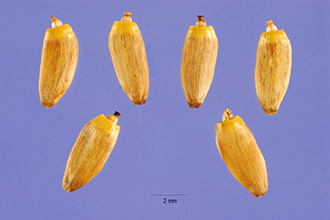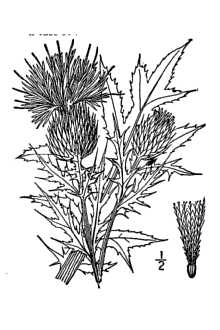Field Thistle
Scientific Name: Cirsium discolor (Muhl. ex Willd.) Spreng.

| General Information | |
|---|---|
| Usda Symbol | CIDI |
| Group | Dicot |
| Life Cycle | BiennialPerennial, |
| Growth Habits | Forb/herb |
| Native Locations | CIDI |
Plant Guide
Use soil moisture sensors to measure the soil moisture of Field Thistle.
Fact Sheet
Alternate Names
Carduus discolor (Muhl. ex Willd.) Nutt
Uses
Wildlife: The large flowers and abundant nectar are very attractive to many species of butterflies, hummingbirds, bees and moths. Many other species will also use other plant parts for food, including the leaves, stems, roots, flower heads and seeds. Seeds are attractive to seed eating birds such as such as the American goldfinch. Ethnobotanical: Field thistle, like other Cirsium species, has edible roots, inner stems, young leaves, young inner parts of flower buds and seeds. Native Americans used a paste of the roots for treating wounds, boils, and piles, and also used an infusion of the root for treating stomach ache. Native Americans also used the thistle down (or pappus) from the seeds to fletch the tail end of blow darts.
Status
Arkansas and Iowa list the entire genus of Cirsium as a noxious weed, including all native as well as non-native species in the genus. Please consult the PLANTS Web site and your State Department of Natural Resources for this plant’s current status (e.g., threatened or endangered species, state noxious status, and wetland indicator values).
Weediness
Seeds are naturally wind dispersed although most seeds fall fairly close to the original plant. Field thistle can sometimes be found in pastures (usually overgrazed), but unlike non-native thistles it is not invasive and weedy in properly managed agricultural fields. Please consult with your local NRCS Field Office, Cooperative Extension Service office, state natural resource, or state agriculture department regarding its status and use. Weed information is also available from the PLANTS Web site at http://plants.usda.gov. Please consult the Related Web Sites on the Plant Profile for this species for further information.
Description and Adaptation
Adaptation
Adaptation
Field thistle is a native biennial or short lived perennial (monocarpic) thistle growing in much of the eastern half of the U.S. and Canada. It can be found growing in meadows, wood edges and openings, field borders, abandoned fields, pastures and roadsides. Field thistle initially grows in a basal rosette form (circle of leaves originating from one growing point at the soil surface). Plants only form flowering stems after growing through at least one winter and sometimes two or three. Stems grow 2–8 inches tall and are branched on the upper third. Stems have white hairs, and lack the spiny wings found on many non-native thistles. Leaves alternate on the stem and have deep spine-tipped lobes. Leaves have a distinctive white mat of fine hairs on the undersides and sparse, week hairs on the upper surface. The lavender pink to light pink, or rarely white flower heads are about 2 inches across and consist of many narrow tube-shaped flowers about 1½ inches long. Flowers billow out from a narrow base, forming a distinctive mushroom shape. The flower base has overlapping green bracts with white center-lines and sharply angled, thin needle like spines. Field thistle can be found blooming from late summer to fall, with individual plants bloom for about a month. Seeds have long downy plumes that aid dispersal by the wind. Plants typically have a large central taproot with some coarse rope-like secondary roots.
Establishment
Field thistle grows well with full sun to partial shade and average to dry soil moisture. It is best to plant field thistle in an area where competing vegetation has been removed. In late fall to early spring, seeds can be sown directly on bare soil and lightly covered with no more than one quarter inch of soil raked or spread over the seed. Seeds may also be sown in containers and transplanted when plants are large enough to be handled. Plants have a deep root system and should not require supplemental water once established. Plants of good size going into winter will generally bloom the following late summer.
Management
Field thistle will die after flowering and maturing seed, but will readily self seed on open soil or with sparse vegetation. Reducing competition from very competitive plants such as tall fescue will yield larger plants.
Pests and Potential Problems
Several introduced species of weevil can cause significant damage to field thistle, Use soil moisture sensors to measure the soil moisture of Field Thistle., The larvae of the Canada thistle bud weevil (Larinus planus) feeds on developing seeds and flower parts, reducing the number and quality of seeds produced, The larvae of the thistle crown weevil (Trichosirocalus horriduscan) feed on the inner parts of the crown where the leaves and stem meet the roots, The resulting damage often leads to a secondary fungal infection that kills the entire plant,
Environmental Concerns
Grazing animals will avoid grazing the immediate area around thistles. Since thistle will tend to grow in the over-grazed areas, this naturally allows areas to recover from over-gazing and therefore may be desirable in natural systems or low intensity unmanaged pastures, but may not be desirable in highly managed pastures.
Control
Field thistle does not spread by underground stems (rhizomes) or roots and is not invasive or as difficult to control as non-native thistles. Unlike the non-native thistles, many of the native thistles have become uncommon in the landscape. Get to know your local thistle species so that you can distinguish the non-native weeds to be removed, from the native species that are important for the pollinators! Please contact your local agricultural extension specialist or county weed specialist to learn what control methods work best in your area and how to use it safely. Always read label and safety instructions for each control method. Cultivars, Improved, and Selected Materials (and area of origin)
Prepared By
R. Jay Ugiansky and Randy Pheobus; USDA, NRCS, Norman A. Berg National Plant Materials Center

